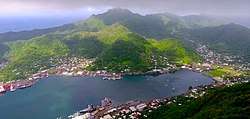Pago (American Samoa)
Pago was an ancient volcano in the center of Tutuila Island, the largest island of American Samoa in the South Pacific Ocean.

The volcano's main shield was formed by subaerial eruption between 1.54 and 1.28 million years ago.[1] It has been estimated that the volcano was as high as 3,937 feet (1,200 m) above sea level.[2] Activity on Pago Volcano ended with emplacement of trachyte bodies with ages of 1.03 ± 0.01 Ma.[3]
The Pago Volcano caldera was formed 1.27+-0.02 million years ago. The caldera's dimensions are estimated at 5.9 miles (9.5 km) in length and 3 miles (4.8 km) in width.[4] The southeast part of the caldera makes up Pago Pago Harbor, one of the world's largest natural harbors. The northwest rim, Maugaloa Ridge, creates the southern border of the National Park of American Samoa.[5]
References
- McDougall, Ian (October 1985). "Age and Evolution of the Volcanoes of Tutuila, American Samoa" (PDF). Pacific Science. University of Hawaii Press. 39 (4): 318.
- MacDougall, p. 314.
- MacDougall, p. 311.
- Keating, Barbara H.; Bolton, Barrie R. (2012), Geology and Offshore Mineral Resources of the Central Pacific Basin, Springer Science & Business Media, p. 152, ISBN 9781461228967.
- Harris, Ann G. (2004), Tuttle, Esther; Tuttle, Sherwood D. (eds.), Geology of National Parks (PDF) (Sixth ed.), Dubuque, Iowa: Kendall/Hunt Publishing Company, p. 614, ISBN 0-7872-9971-5.